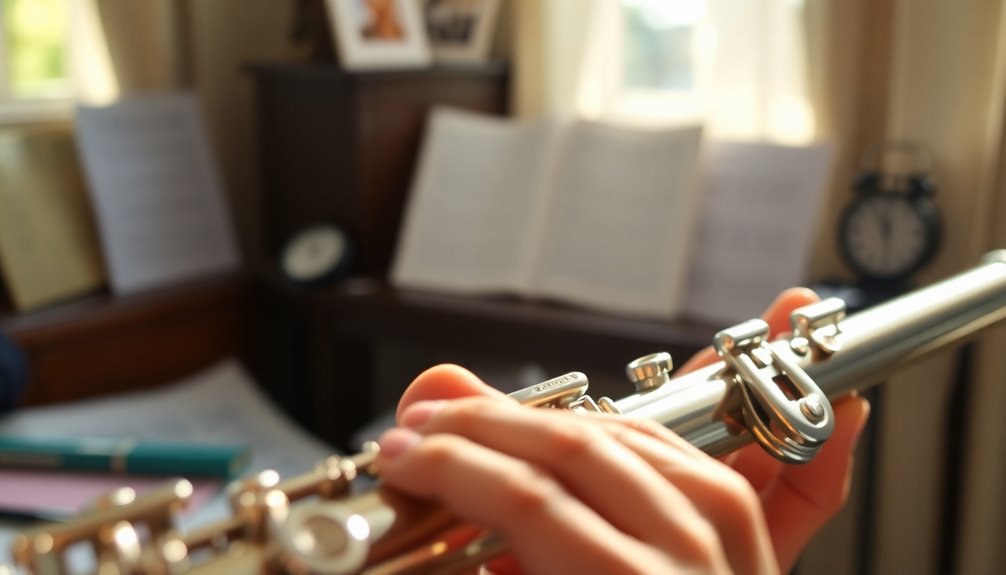To boost your finger agility on the flute, start with regular finger exercises that challenge your independence and coordination. Incorporate major and minor scales into your daily practice, focusing on varied articulations to develop dexterity. Don't forget to add arpeggios, as they're essential for building speed. Finally, use a metronome to improve your timing; begin at a comfortable pace and gradually increase the speed to sharpen your precision. These strategies will transform your playing. If you're keen to discover more techniques that can elevate your flute skills, there's plenty more to explore.
Key Takeaways
- Incorporate regular finger exercises to enhance agility and coordination, focusing on drills that challenge finger independence.
- Master major and minor scales, practicing variations and articulations to improve dexterity and musicality.
- Use a metronome to develop timing accuracy; gradually increase tempo to build speed without sacrificing precision.
- Join a flutist community for shared learning experiences, gaining motivation and new techniques from peers.
- Track progress by recording practice sessions, setting specific goals, and seeking feedback for continuous improvement.
Practice Finger Exercises Regularly

To truly enhance your finger agility on the flute, it's vital to practice finger exercises regularly. These exercises aren't just warm-ups; they're fundamental for developing the finger patterns and hand coordination you need to play fluidly.
Start with simple drills that focus on specific finger combinations. For instance, try alternating between notes like C, D, and E. This will help you familiarize yourself with the finger patterns and improve your muscle memory.
Set aside dedicated time each day for these exercises. Consistency is key. As you progress, challenge yourself with increasingly complex patterns, such as scales or chromatic runs. You'll find that your fingers become more independent, allowing you to navigate the flute with ease.
Pay attention to your hand coordination during practice. Confirm your fingers move smoothly and efficiently, avoiding unnecessary tension. This not only improves your agility but also enhances your overall playing experience. Incorporating scale and arpeggio practice into your routine can significantly boost your finger agility.
Record yourself to monitor your progress; this can provide valuable feedback and keep you motivated.
Join a community of other flutists who share the same goal of improving their skills. Sharing your experiences and challenges can foster a sense of belonging and inspire you to push further.
Focus on Scales and Arpeggios

Mastering scales and arpeggios is essential for developing finger agility on the flute. By focusing on these fundamental elements, you'll not only improve your finger dexterity but also enhance your overall musicality. Start with basic major and minor scales, and as you gain confidence, incorporate scale variations. Experiment with different articulations, such as staccato and legato, to challenge your fingers further. This diversity will keep your practice sessions engaging and rewarding.
Next, immerse yourself in arpeggio patterns. Arpeggios are vital for moving fluidly between notes, and practicing them regularly can greatly boost your finger speed and coordination. Begin with simple triads and gradually work your way up to more complex arpeggios, including seventh and extended chords. As you practice, focus on evenness and clarity in each note, ensuring your fingers move smoothly across the keys.
To make your practice even more effective, consider combining scale variations and arpeggio patterns in one session. For instance, play a scale followed by its corresponding arpeggio, alternating between different articulations. This approach not only strengthens your finger agility but also helps you internalize the relationships between notes. Moreover, mastering dynamic range through long tone practice can further enhance your overall technique and musical expression.
Utilize a Metronome for Timing

Incorporating a metronome into your practice routine can greatly enhance your timing and rhythm on the flute. By using effective metronome techniques, you can develop timing accuracy that will elevate your playing. Start by selecting a comfortable tempo; this will serve as your foundation. Gradually increase the speed as you become more comfortable with the notes and fingerings.
Here's a simple table to help you structure your practice sessions:
| Tempo (BPM) | Exercise Type | Duration | Focus Area | Notes |
|---|---|---|---|---|
| 60 | Scales | 5 minutes | Finger placement | Slow and steady |
| 80 | Arpeggios | 5 minutes | Smooth shifts | Maintain evenness |
| 100 | Simple Melodies | 5 minutes | Rhythm consistency | Emphasize beats |
| 120 | Complex Phrases | 5 minutes | Articulation | Clear note starts |
| 140 | Fast Passages | 5 minutes | Finger agility | Push your limits |
As you practice, pay attention to how your fingers respond to the metronome's steady beat. If you find yourself rushing or dragging, slow down and refocus. Remember, it's all about building a solid foundation. Additionally, consistent practice with a metronome will foster overall improvement in your musical performance. Stick with this routine, and you'll soon find that your finger agility and overall flute playing improve drastically. Consistency is key, and you're part of a community that values precision and passion in music!
Frequently Asked Questions
What Type of Flute Is Best for Developing Finger Agility?
When you're looking to develop finger agility, a wooden flute with closed holes is an excellent choice.
The closed-hole design encourages precise finger placement and movement, helping you build strength and dexterity. Wooden flutes also offer a warm, rich tone that can inspire you to practice more often.
How Long Should I Practice Finger Exercises Each Day?
Did you know that consistent practice can boost your skill level by over 50% in just a few months?
To develop finger agility, aim to practice finger exercises for about 15 to 30 minutes each day. Incorporate this into your daily routine, and you'll notice improvement.
Consistency is key; even short sessions can be effective. Make it a habit, and soon you'll feel more confident and connected with fellow musicians.
Can I Improve Finger Agility Without a Teacher?
Yes, you can definitely improve your finger agility without a teacher!
Utilize online resources like video tutorials and forums to find self-taught techniques that resonate with you. Set aside time each day for focused practice, incorporating exercises that challenge your dexterity.
Engage with fellow musicians online to share progress and tips. Remember, consistency and dedication are key, and you'll see improvement as you explore these techniques on your own!
Are There Specific Fingerings That Enhance Agility on the Flute?
Did you know that 80% of flutists struggle with finger agility at some point?
To enhance your agility, focus on specific fingerings that require quick changes. Incorporate agility exercises like scales and arpeggios, emphasizing tricky fingerings.
Practicing these consistently won't only improve your dexterity but also build confidence.
Does Hand Size Affect Finger Agility on the Flute?
Yes, hand size can affect your finger agility on the flute.
If your hands are smaller, you might struggle with hand positioning, making it harder to reach some keys comfortably. This can impact your finger strength and speed.
However, with practice and the right techniques, you can improve your agility regardless of hand size.
Focus on exercises that strengthen your fingers and enhance dexterity, helping you feel more confident and capable while playing.
Conclusion
By consistently practicing finger exercises, honing your scales and arpeggios, and using a metronome, you'll transform your flute playing from a clumsy dance to a graceful ballet. Just like a sculptor chisels away at stone to reveal beauty, your dedication will carve out agility and precision in your fingers. So, embrace these tips and watch as your skills flourish, letting your music flow like a river, smooth and unwavering. Your journey to mastery starts today!






